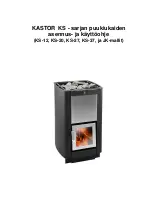
12
Vermont Castings Aspen
®
II Multi-Fuel
30003892
connecting the flue pipe connector
The flue pipe connector should be secured to the stove
flue collar using the three (3) self-tapping screws pro-
vided in the hardware bag. Secure the flue pipe through
the holes in the flue outlet of the stove. The joint should
then be sealed with stove cement or flue joint sealant
designed for solid fuel applications.
operation
configure the Stove for your fuel
As shown in Figure 15, two adjustments are necessary
depending on whether wood or coal is being burned
in the Aspen II. It is important to configure your stove
correctly in order to achieve proper burning and the
efficiency and emissions performance the stove is rated
for.
The stove is supplied with a hearth plate which is
installed on top of the shaker grates for wood burning.
This plate is NOT used when burning coal. Further,
there is a reversible plate located under the ash pan
which directs incoming combustion air to the air wash
above the glass door, for wood burning, or beneath
the shaker grate for coal burning. Symbols showing a
basic operation of the Stove
This stove is a premium product constructed from cast
iron, and if looked after, will last for many years, even
with constant use. The controls are simple to use and
comprise a bypass damper that opens or closes the
flue outlet and a primary air control lever. The primary
air control provides a range of heat ouput settings.
The bypass damper can be opened to increase flue
draught for starting or rekindling the fire, and is closed
to provide secondary combustion of the flue gases by
forcing the flue gases through the louvers in the rear of
the firebox and into the secondary chamber.
Secondary combustion occurs in the secondary com-
bustion chamber in the rear of the firebox. The high
temperatures attained in this area encourage further
burning of the volatile gases in the smoke, reducing
emissions, reducing creosote deposits in the flue and
increasing the efficiency of the stove. Long burn periods
are achieved when the stove is in secondary combus-
tion mode with the bypass damper closed and the
primary air control set to its most closed position.
using the controls
Two controls are used to regulate the performance of
the Aspen multifuel. A primary air control lever (situated
underneath the front of the stove) regulates the sup-
ply of air to the fire. A damper (situated at the left hand
rear of the stove) opens and closes the direct flue outlet
from the rear of the firebox. In the closed position this
damper directs the flue gases through the secondary
combustion chamber in the rear of the stove, and in the
open position allows unrestricted flow of the flue gases
in to the flue, thereby increasing flue draught.
34
HEARTHPLATES
Hearth Plate
(Install on grates for wood
burning only)
Bottom Plate
Bucket
Toward Front
for Burning
Coal
Tree
Toward the
Front for
Burning
Wood
ST921
fig. 15
Position the hearth plate and bottom plate depending
on fuel being used.
coal bucket and a tree are cast into this plate. The tree
symbol should be oriented toward the front (nearest the
door) for wood burning and the coal bucket should be
oriented toward the front for coal burning.
+4
!SPEN))CONTROLS
Damper
Control
Primary Air
Control
ST881
fig. 16
Aspen II Multi-fuel heater air controls.
primary air control
The primary air control lever, located underneath the
front of the stove, controls the amount of incoming com-
bustion air for starting, maintaining and reviving a fire.
More air entering the stove makes the fire burn hotter
and faster, whilst less air prolongs the burn at a lower
heat level.













































